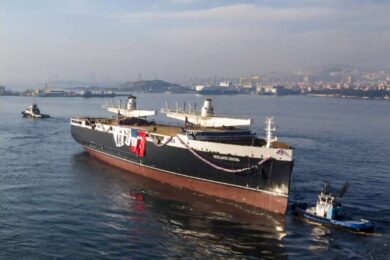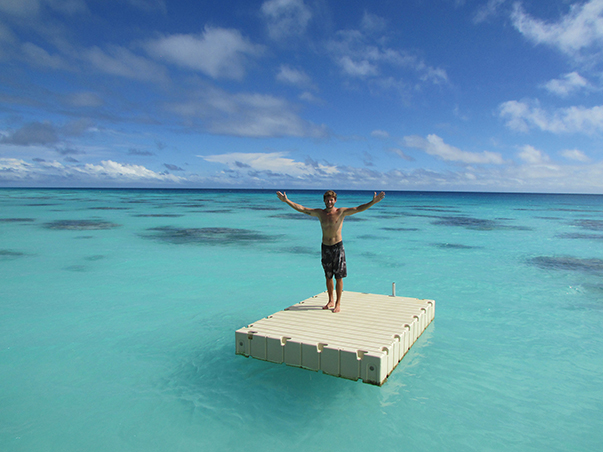A South Pacific dream is fulfilled with a passage west (published August 2013)
Will opened his sleepy eyes and looked at me with a puzzled expression as I burrowed my face in his shoulder and tried to hold back my tears. We were on day four of our crossing of the Pacific Ocean and so far, other than being a rough ride, the conditions and atmosphere aboard Hydroquest had been manageable.
“Are you okay?” he ventured, trying to determine if something was really wrong. I sniffled, wiped my cheeks, and gathered my thoughts. “I can’t live on a…. a”, I could hardly get the words out: “A b-b-b-bug boat” “A what?” He was snickering now. “A bug boat…” I moaned. “You know, a boat full of bugs.” Having a bit of a phobia in this department, I couldn’t help getting ahead of myself; one bug actually means more than one, right? Perhaps there would be a whole nest of eggs somewhere among the baskets of fruit or in the cereal cupboard, just waiting to hatch and form a society of creepy-crawlers aboard Hydroquest. They would mutiny, no doubt. I pictured being stuck on the boat for another two weeks with bugs in our food, bugs in our clothes and bugs crawling all over my face while I slept.
Minutes earlier, Katy, whose nausea had finally subsided, had bravely decided to bake muffins. That was when she opened up the cutlery drawer and saw the bug. To be exact: the big black cockroach.
THE PLAN AND PREPARATION
The dream of sailing to the South Pacific is a powerful one. Tall swaying palm trees over clear blue water on lush tropical islands—the vision is so beautiful that it makes sense to persevere through whatever’s thrown in your path to get there.
Boats sailing to French Polynesia from North and Central America leave as early as February and up until the end of June. The most common departure points are San Diego, Calif., Cabo San Lucas or the Banderas Bay area of Mexico, and Panama via the Galapagos. All routes are a similar distance: between 2700 and 3000 nautical miles across one of the longest stretches of open water on earth.
Our dream began six years ago on our first date at small bar on Vancouver, British Colombia’s West Broadway Street. The plan evolved over time but the fundamental elements never changed—we would buy a boat in southern California or Mexico and sail her to the islands of the South Pacific. In late 2011 we found our 1986 Beneteau First 405 in Guaymas, Mexico, and she met the criteria that we felt were important for making an offshore voyage: a strong hull and solid design, updated rigging and the ability to sail fast.
We cruised in Mexico for the first year, getting to know Hydroquest and adding additional gear for the passage. The months passed quickly and suddenly we were as ready as we could be to finally go.
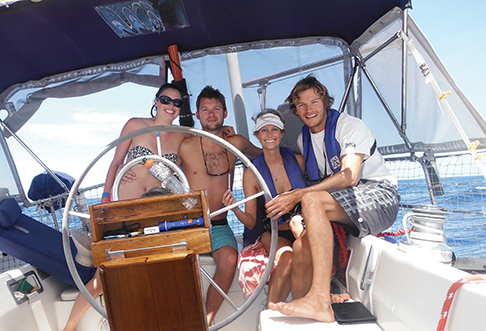
Will’s brother Ben and his girlfriend Katy joined us in Nuevo Vallarta on March 24, 2013. Before they had a chance to unpack their bags we were checking out of Mexico and watching for the right weather window. Ideally, it would be a system to the north that would bring wind down the coast to act as an “attachment” to the northeast trade winds that don’t normally fill in until approximately 300 to 500 miles offshore.
SAILING INTO THE SUNSET
We sailed west into the red and yellow sunset on the evening of March 28th. In the years leading up to the crossing, I’d woken up some nights with feelings of panic about the idea of such a long voyage all alone in the ocean. What if something happens to the boat, what if someone gets sick, what if we don’t make it? But a wonderful thing happened after pulling up the anchor in Punta de Mita and setting sail—in all the excitement, my worries and my fears completely disappeared.
Will’s feeling upon setting sail was that of immense relief. The preparation for the passage was undoubtedly more stressful than actually being out on the water.
Our strategy was twofold: set a waypoint for Nuku Hiva, Marquesas, and sail as close to the rhumb line as possible while keeping the boat comfortable. We were lucky to have timed our departure perfectly and we caught the wind on the tail end of a system that filled our sails from the first night onward.
ADJUSTING TO LIFE AT SEA
We didn’t anticipate how lumpy and bumpy the seas would be. From the get-go we experienced two to three competing swell patterns that hit Hydroquest on her stern and either beam. She performed brilliantly and could handle it all. It was us who had to adjust.
Day Two
17 37.94N 109 19.05W
Heading 210T Wind 20 NW
Avg Speed 7.5 knots
We are slowly adapting to life at sea. Yesterday the winds picked up to 20 knots in the late morning and they haven’t let down since. Hydroquest has averaged a boat speed of 7+ knots over the past 36 hours. We are moving, and in the right direction! With the winds have come lively seas so we’ve been bouncing around a lot, trying not to bump into things as we walk around the boat, and having a hard time sleeping.
I was on watch from 4:00am to 6:30am this morning. I had the egg timer set for 15 minute increments and every time I started to nod off, I heard a weird buzzing noise. I shone my headlamp around the cockpit, at the sails and at various lines, but I couldn’t figure out what it was. After sunrise Will found the culprit—a flying fish trapped under the cockpit floorboard. Hydroquest’s deck revealed dozens more ill-fated fishies and one baby squid.
We passed three freighters yesterday and one this morning. We all had a good chat with a bird yesterday.
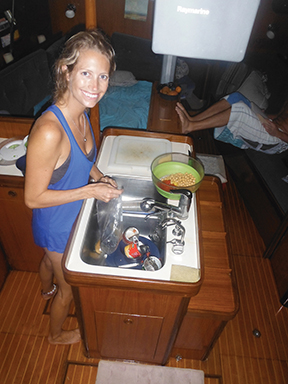 During the first few days we ate simply—pasta, bread, Kraft Dinner, noodles and cereal. Cooking was a difficult chore. As we acclimatized to the irregular motion and came to terms with the fact that the washing machine seas were not going to dissipate, we began concentrating on passing the time. Our favorite games were “Dead or Alive”—guessing the names of famous people—and “Sink or Float”—throwing organic garbage into the water and predicting its fate. These games were absurdly entertaining at the time.
During the first few days we ate simply—pasta, bread, Kraft Dinner, noodles and cereal. Cooking was a difficult chore. As we acclimatized to the irregular motion and came to terms with the fact that the washing machine seas were not going to dissipate, we began concentrating on passing the time. Our favorite games were “Dead or Alive”—guessing the names of famous people—and “Sink or Float”—throwing organic garbage into the water and predicting its fate. These games were absurdly entertaining at the time.
Having four people aboard played a huge role in our comfort; watches were short and there was always someone to chat with. The miles kept ticking by and we passed hours upon hours reading, eating, sleeping, adjusting lines and changing the sail configuration from time to time. I would like to say that we did a lot of sailing, but really it felt like Hydroquest was sailing herself.
THE ITCZ
The Inter-tropical Convergence Zone (ITCZ) is an area of low pressure around the equator where the prevailing winds are light. It appears as a solid band of clouds consisting of showers, with occasional thunderstorms and can extend for many hundreds of miles. The band is constantly shifting so having a weather router on shore with the ability to download satellite images of the area is a great strategy. It’s possible to see the ITCZ’s narrowest section and therefore pinpoint the best longitude to cross.
As Hydroquest approached the low latitudes, the information we had indicated that the band was thick all the way across. There was no use in altering course so we maintained our heading towards Nuku Hiva. Using radar we were able to track squalls, but there were too many to avoid so after a while we gave up trying.
Day 10
05 13N 124 32W
Heading 210T Avg speed 5.5 knots
Wind 12 E
We are officially over halfway and I think it’s safe to assume that we’re in the ITCZ. Last night we went through six rain and wind squalls: torrential downpour (Vancouver-style) followed by winds of up to 35 to 40 knots. Luckily they don’t last very long but the boat has become one soggy mess! All of our towels are completely soaked, our bed is damp from a hatch being left open and the air is so muggy that there’s no way anything or anyone is going to dry out.
Today we took a group shower in the cockpit when one of these squalls passed overhead. It was hilarious—all of us in our swimsuits covered in shampoo and soap just willing the water pressure to be turned up a notch (it was a light one). Now it hasn’t stopped raining for over eight hours. Our Hydrovane is steering us (as it has for the past ten days!) and we’re all hiding out down below in our clammy cave.
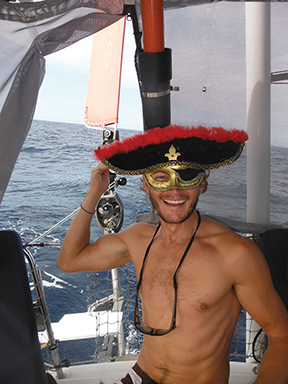
CROSSING THE EQUATOR, OFFICIALLY IN THE SOUTH PACIFIC
On day 13, at latitude zero and longitude 128, we finally broke through the northern ITCZ clouds and were greeted with warm sunshine, a perfect 15 knots of wind and the first really pleasant conditions we’d experienced on the whole trip.
Ben must’ve made a deal with King Neptune. He and Katy disappeared onto the foredeck for ten minutes and from down below we heard laughter and exclamations, much more enthusiasm than expected from taking down laundry.
Shortly after, Katy thrust her hand down Hydroquest’s companionway to show off her new bling—an engagement ring! Racking up minutes on the satellite phone to call home was worth it for them to say, “We’re at the equator in the middle of the Pacific, and we’re engaged!”
In spite of our happy attitudes onboard in the following days, the South Pacific Ocean refused to maintain a comfortable state.
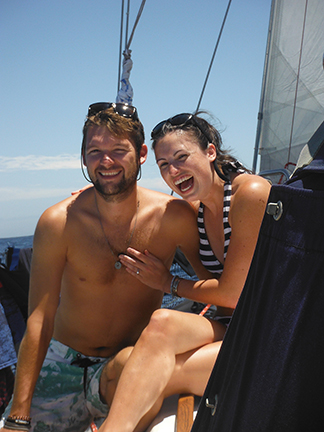
Day 15
02 52S 131 04W
Heading 230T Avg speed 7.5 knots
Wind 18 – 22 knots from SE
We’ve finally hit the southeast trade winds that are going to push us all the way to the Marquesas. Blue skies, fluffy white clouds, a consistent 18 to 22 knots, and no more squalls on the horizon (thank goodness—they were starting to get really annoying). A big swell is up once again, also from the SE. The feeling is different from the washing machine effect; now it’s more like a sideways bucking bronco.
KISSING THE GROUND
I’m sure it’s no surprise to hear that all of our conversations on the final two days at sea were about land. We discussed the amazing foods we’d eat—ice cream, cappuccinos, pizza!—made bets on our arrival date and time, re-read our guidebooks with newfound interest and watched the miles tick off the chartplotter as if it were a blockbuster movie.
Day 18
07 06S 138 26W
Heading 215T Avg speed 6.0 knots
Wind 12 SSE
We are so close. Katy promises to dive onto land. I plan to kiss the ground. Ben is going to drink 10 tropical cocktails and go “missing in action” for at least two days. Will looks forward to actually wanting to drink a beer. 145 miles to go!!! ETA: sometime tomorrow afternoon.
We made landfall in Taiohae Bay, Nuku Hiva, Marquesas, at 1700 on April 16, 2013. The faint outline of land had appeared on the horizon in the morning and it slowly developed into the majestic cliffs of Cape Tikapo. Could we see faces in the rock, or had we just been at sea for too long?
Once Hydroquest was safely anchored, the dinghy took 10 minutes to inflate and deploy and before we knew it we were clambering onto the concrete pier. Katy was the first one to step on land and she promptly dropped onto the muddy ground and did a “land” angel. Will, Ben, and I followed suit by kissing the ground. The feeling was amazing—we were giddy, we couldn’t stop laughing and we couldn’t quite balance properly on our own legs. The feelings of accomplishment and satisfaction ran deep through our hearts.
REFLECTIONS
The fact that my worst moment during those 19 days at sea was finding a cockroach onboard perhaps reveals that our crossing was a relatively easy one. The roach was a loner, thank goodness! Despite the uncomfortable seas we had hardly any breakage, never encountered sustained winds higher than 25 knots and didn’t suffer from light airs. There were beautiful moments and frustrating moments, but more than anything the voyage was an endurance test in passing time.
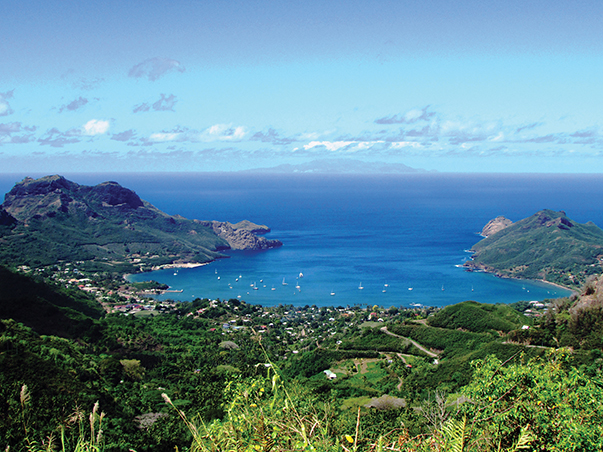
Would we do it again? After our first week on land, we were unsure of the answer to that question. Now, after weeks traveling through the Marquesas, Tuamotus, and Society Islands, and forgetting the boredom and long days it took to get here, the answer is a resounding YES. It will always be one of the biggest achievements of our lives and the truth is that French Polynesia in real-life far exceeds the dream. It is so very worth it.
Sarah Curry has put her Human Resources career on hold to jump into cruising with her husband Will on Hydroquest, their Beneteau First 405. After cruising Mexico’s Pacific Coast, making the passage to the South Pacific and spending the summer months exploring they plan to set sail for Australia.

